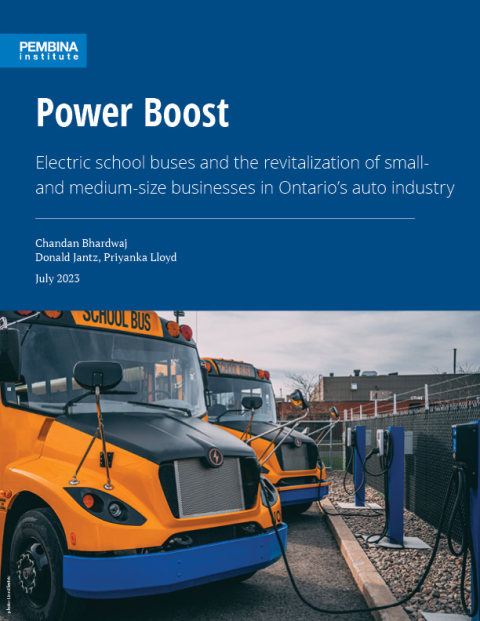Globally, the electric bus market is projected to reach US$3.1 billion in sales by 2030, increasing year over year at a rate of 18%. A similar growth spurt is underway in the North American electric bus market which is predicted to nearly double within the next two to three years. Ontario can take advantage of the economic dynamics in the auto sector by leveraging its well-established infrastructure and workforce in the automotive industry. Investing in the production and sales of electric school buses has the potential to make a significant contribution to the revival of Ontario’s commercial vehicle manufacturing industry and help secure economic benefits and stability for its small- and medium-size business sector.
Once an economic powerhouse, this is a pivotal moment for Ontario’s medium- and heavy-duty vehicle (MHDV) manufacturing sector. The heavy truck and bus industry practically collapsed in Ontario after the 2008 financial crisis. Despite signs of recovery in the past decade, the sector is still operating at only 10% of its pre-2008 production levels as indicated by the industry’s economic output, putting the survival of small- and medium-sized enterprises (SMEs), which have been central to the growth of Ontario’s MHDV sector, at risk.
All the more reason for Ontario to take advantage of the transition to zero-emission transportation. A growth sector that impacts all segments of the auto industry, the transition away from diesel fuelled vehicles presents a unique opportunity for the production and purchase of electric school buses (ESBs) in particular.
Benefits of electric school buses
Of all the categories of large trucks and buses, ESBs are one of the easiest to electrify. For every dollar invested in the sector, as many or more jobs are created compared to light-duty vehicle manufacturing. If 65% of Ontario’s school bus stock is electrified by 2030 (which is Quebec’s target for school bus electrification), multiplier effects along the ESB supply chain could cumulatively create more than 13,000 jobs and generate nearly $2 billion in economic output in Ontario by 2030.
To date, Ontario has primarily invested in the supply side of the EV sector while demand-side policies have been overlooked, despite evidence that demand focused policies such as purchase incentives are more effective at growing local markets than are subsidies targeting manufacturers.
Opportunities for Ontario
Because the Ontario government funds school bus purchases, it is able to take the following steps to increase the number of electric school buses produced and purchased within the province:
- Increase awareness among operators of the economic advantages of electric school buses. An ESB Toolkit, for instance, would be a useful resource and means of disseminating information about zero-emission buses, including guidance on best practices for adoption, and consumer advice on conducting due diligence before making a purchase.
- Encourage Ontario schools to buy electric school buses. The province can offer grants to school districts to offset the sticker price of an ESB which is significantly higher than that of internal combustion buses.
- Build out charging infrastructure to accommodate an increase in the number of electric school buses and encourage purchases. Ontario will need to quadruple its commitment of $91 million to build chargers and include at least five fast charging stations (>100 kW) in each of the 72 school districts by 2030.
- Invest in training programs for Ontarians in ESB manufacturing, operation and maintenance. BecauseOntario’s training programs in the automotive sector recently ended, we recommend that the province revive the program in anticipation of almost certain increases in demand for a skilled workforce to fill labour gaps throughout the ESB industry from resource extraction to operations and maintenance.
Accelerating the electrification of school buses can be done cost effectively and will additionally contribute to the revitalization of SMEs in the auto sector, lower Ontario’s carbon emissions, and make a meaningful contribution to positive health outcomes.




